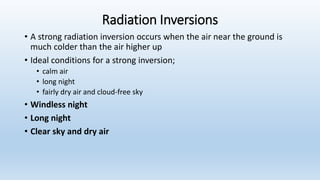Night time cooling
- 1. NIGHTTIME COOLING âĒ As the sun lowers, its energy is spread over a larger area âĒ In late afternoon or early evening, the earthâs surface and air above begin to lose more energy than they receive âĒ The ground and air above cool by radiating infrared energy, a process called radiational cooling âĒ The land is much better radiator than air âĒ Surface air transfers some energy to the ground by conduction âĒ The measured increase in air temperature just above the ground which is formed mainly through radiational cooling of the surface is known as a radiation inversion âĒ As radiation inversions occur on most clear, calm nights, they are also called nocturnal inversions
- 3. Radiation Inversions âĒ A strong radiation inversion occurs when the air near the ground is much colder than the air higher up âĒ Ideal conditions for a strong inversion; âĒ calm air âĒ long night âĒ fairly dry air and cloud-free sky âĒ Windless night âĒ Long night âĒ Clear sky and dry air
- 5. âĒ On winter nights in middle latitudes, it is common to experience below-freezing temperatures near the ground and air 5°C warmer at your waist âĒ Top of the inversion is usually not more than 100 m above the ground âĒ A surface that is wet or covered with vegetation can add water vapor to the air âĒ Lowest temperature on any given day is usually observed around sunrise âĒ Cold, heavy surface air slowly drains downhill during the night and eventually settles in low-lying basins and valleys







